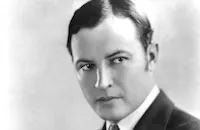The Saddle Buster

Brief Synopsis
Cast & Crew
Fred Allen
Tom Keene
Helen Foster
Marie Quillan
Robert Frazer
Richard Carlyle
Film Details
Technical Specs

Synopsis
After growing up in the hills with his foster father, Bible Jude, young Montana rides to a rodeo ranch run by an old friend, Dan Hurn, and asks for work. Impressed with Montana's considerable riding skills, which were developed catching and taming wild hill mustangs, Dan eagerly accepts Montana into the group. Top rider Rance, however, resents Montana's success and bets the other riders that Montana cannot ride "Wild Fury," Hurn's most notorious horse. Although the other men and Hurn's daughter Sunny beg Montana not to ride Wild Fury, Rita, a rodeo rider who has abandoned Rance in favor of Montana, encourages him. Montana's ride on the wild stallion is cut short when his cinch, which has been cut by Rance, breaks and he tumbles to the ground. While he is down, Wild Fury paws him viciously, causing him serious injuries. During his recuperation, Montana is haunted by the terrifying image of Wild Fury, but is comforted by the devoted Sunny. Soon after, Montana returns to the saddle but, upon seeing the spectre of Wild Fury before his eyes, is thrown after a short ride. Humiliated by his fears, Montana slips away from the ranch and finds a deserted cabin in the hills. There, Montana discovers a mustang, which Hurn had previously tested and rejected as "yellow," and snares it. Sure that the horse will be an easy ride, Montana mounts it, but soon realizes that the stallion, like himself, is no coward. Now determined to confront Rance, Montana goes to Coulee City where Hurn's company is participating in their first rodeo of the season, but discovers that Wild Fury has put his rival in a wheelchair. His anger deflated, Montana then finds out from Sunny that the crippled Rance, who has married Rita, needs money for an operation in Cheyenne. With a final burst of courage, Montana decides to ride Wild Fury in the rodeo and wins a $1,000 prize. After donating his winnings to Rance, Montana proposes to a proud Sunny.

Director
Fred Allen
Cast
Tom Keene
Helen Foster
Marie Quillan

Robert Frazer

Richard Carlyle
Charles Quigley
Fred Burns
Harry Bowen

Charles Whitaker
Ben Corbett
Al Taylor
Crew

Film Details
Technical Specs

Articles
The Saddle Buster
By Richard Harland Smith

The Saddle Buster
Quotes
Trivia
Notes
The working title of this film was Montana Rides. Arthur Lange is listed as the film's music director in some reviews, publicity items and in the copyright records, but Max Steiner is credited on screen. According to modern sources, the budget for the production, which grossed $25,000, was a modest $38,000.














